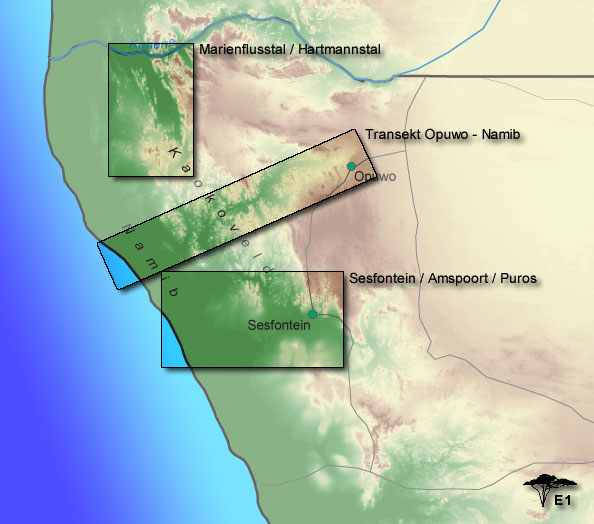|
The aim of the investigations is to reconstruct the development
of the landscapes of Kaokoland during the late Holocene with special reference
to relief forms. Based on the division of the natural regions, the naturally
and anthropogenic induced changes of the landscape will be recorded. Our
interest focuses on the processes of soil erosion that has gone hand in
hand with disturbances of the vegetation due to pasturing since the beginning
of the pastoral-nomadic land-use. Furthermore, we will cover the temporal
perspective of the transition from a natural landscape to a cultural landscape
(German expression: ‘Kulturlandschaft’), i.e. from the outset of pasturing
until the technological impact in our times (road construction, mines...)
Elaborating the pattern of natural landscapes of the area
and analysing the indications of climatic fluctuations during the Holocene
will serve to reveal the structure of regions favourable for pastoral
nomadism or as supplementary pastures and regions for temporary retreat
in its spatial and temporal variation. Thus, this structure will show
potential settlement and pasture areas as well as guidelines, which
are important for the spread of economic innovations.
In connection with the research projects on the development
of continental margins (E. Brunotte and J. Spönemann) and relief
genesis in the region of the North Namibian Anorthosite-Complex (H. Sander),
which both run outside of the SFB, these investigations will yield a comprehensive
description of Kaokoland with respect to the morphology and the genesis
of the landscapes including an overview map of the main geomorphological
features.
Methods
Not only the classical morphographic-morphometric field methods
(terrain observation, surveying, mapping, profile records) but also
remote sensing
(mapping and surveying by means of air photos, analysing of satellite
images), dating methods (e.g. radiocarbon dating, theroluminescence
[TL]
and optical stimulated luminescence [OSL]) and laboratory analyses
(e.g. micromorphology, X-ray-diffractometry, grain size determination,
pH-value)
are applied.
Phase 1 of the project (1995-1998)
The field work of the first phase of the project was implemented
by E. BRUNOTTE and H. SANDER with the assistance of students. The major
spatial
and thematic topics included:
- Investigating the pattern of natural regions based on the distribution
of relief units, debris-mantles and soils (following sections from the
rim of the Namib to Ovamboland).
- Investigating the effects of the longstanding pastoral nomadism in
loess-covered basins of central Kaokoland (Opuwo, Omungunda),
- Investigating in detail the floodplains with their fine sediments
and the river bed patterns in the Kunene valley as a potential immigration
guideline,
- The proof of the interrelations amongst over-use, degradation and
changes of land-use in Omuhonga (northern Kaokoland) in close co-operation
with botanists and ethnologists.
Phase 2 and 3 of the project (1998-2004)
In continuation of the sections mentioned above, the present
investigations focus on regions of supplementary pasture and regions of
temporary retreat. With special focus on the aspect of shifting desert
margins.
- K. HARTMANN works on the rim of the Namib including the
Marienfluß valley
and the Hartmann valley
- The south and the west rim of Kaokoland north
of the Hoanib river (the region of Sesfontein and Puros) represents
another area of major interest (O. BÖDEKER). He finished his
investigations in 2004 with the PhD-Thesis Sedimentological and geochronological
investigations
to
reconstruct late quaternary landscape- and climatic changes in
southwestern Kaokoland (NW-Namibia)
- The investigation of colluvial
sediments and soils of the major
landscapes of Kaokoland is continued by E. BRUNOTTE and students.
Phase 4 of the project (2005)
K. HARTMANN finishes her PhD-Thesis Geomorphological, sedimentological
and geochronological investigations to reconstruct the landscape
evolution and the climatic changes on the eastern rim of the Namib
Desert in northwestern Kaokoland (Hartmanns Valley and Marienfluss
Valley, Namibia). |


